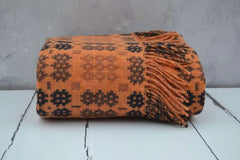Workshops
Dye House
Curiosities
Paint & Scribe
Welsh Blankets
Welsh Blanket Patterns
Summary - Traditional Welsh Blanket Patterns
This Article describes the different patterns used in the weaving of traditional Welsh tapestry style blankets. The Caernarfon (or Portcullis) pattern is the most popular but there are others, for example the Pennsylvania and the Dyffryn.
Nothing says 'Hiraeth' more than iconic Welsh blankets.
| Welsh Blankets Browse ALL Welsh Blanket Articles |
Browse Welsh Blankets in TirGlas Online Shop Have a look around |
Welsh Blanket Pattern Names - Caernarfon, Dyffryn Pennsylvania and Penmachno
The Caernarfon (or Portcullis) pattern is in many of our blankets and is among the most iconic of all Welsh blanket patterns names. If you think of a Welsh tapestry pattern, then this Caernarfon pattern is likely to be the most familiar thanks to its increased production in the 1950s and ‘60s. There are some experts that believe the classic Welsh patterns were the precursor of many of the North American folk art textile traditions, largely as a result of widespread Welsh emigration during the 1790s onward. In areas such as Pennsylvania, where the Welsh settled in significant numbers, the quilts and blankets of the neighbouring Amish are almost identical to Welsh tapestry blankets.
The other classic patterns are the Dyffryn (also Anglicised as Duffryn), Pennsylvania and Penmachno patterns which are much rarer than the Caernarfon pattern. In addition, each mill would often have their own patterns, many of which are no longer available.



Caernarfon Portcullis Pattern
TirGlas Tapestry Blanket - Named Dinefwr
The Caernarfon (or Portcullis) pattern is one of the most iconic and traditional Welsh blanket patterns. It is a geometric design that features a series of interlocking portcullises, a heraldic symbol of authority. The pattern is typically woven in two to four colours, with the portcullises in one colour and the background in another.
The most distinctive style of Welsh blanket is the tapestry (or double-weave – a double cloth blanket made by weaving two layers of material together so it is reversible) with its dominant repeat pattern.

TirGlas Tapestry Blanket - Named Hiraeth
A contemporary design and colours blanket woven at Melin Teifi. We plan to have our design and colours rewoven in the future.

Contemporary Welsh Blankets
Welsh tapestry blankets are very popular, and the demand is greater than can be woven. As a result, there are a number of smaller tapestry style blankets available all with the iconic Welsh blanket patterns. In our online store we have a range of these Welsh blankets for sale, all woven in Wales in a truncated version of the Caernarfon pattern. All are approximately 175 x 145 cms [70 x 55 inches] and are generally softer to touch and smaller than the traditional Welsh tapestry blankets.
Here is a small selection of our range of Welsh blankets - all available in our online shop.








| Welsh Blankets Browse ALL Welsh Blanket Articles |
Browse Welsh Blankets in TirGlas Online Shop Have a look around |
Waffle Blankets - A Different Type of Blanket Pattern
A waffle blanket or honeycomb weave blanket is a woollen blanket woven with a textured, grid-like pattern. They actually do look like a honeycomb or a waffle!!
Waffle blankets creates small square pockets that trap air, making the blankets warm yet breathable. Our waffle blanket are woven with wool and are positively sumptuous. Waffle blankets are versatile for layering on beds or sofas and add a stylish, textured look to home décor. They are popular for their comfort, practicality, and aesthetic appeal.

Conclusion
The Caernarfon Portcullis pattern is the most iconic and well known Welsh blanket pattern. Possibly, they are more popular today than when they were first woven centuries ago.
| Welsh Blankets Browse ALL Welsh Blanket Articles |
Browse Welsh Blankets in TirGlas Online Shop Have a look around |
Join our Priority Membership
Always be first to know - sales, promotions, new products and Thank You discount codes. Not more than 3 to 5 emails per month




















